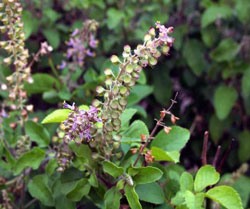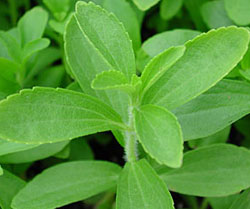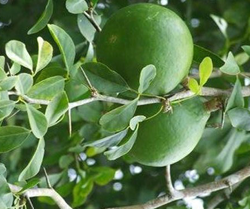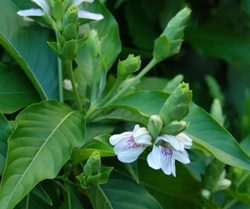- Email: sales@malharenterprises.net.in
- Phone: +91 9004684904
LEAVES
- Home / Leaves
Leaves
Tulsi / Ocimum Tenuiflorum / Ocimum Sanctum
Sanskrit : TulasiEnglish name : Saint Joseph's Wort
Cultivation :Several other basils, including some other Ocimum species, are grown in many regions of Asia. The most notable is the holy basil or tulsi, a revered home-grown plant in India and Nepal.
Medicinal Uses :The leaves and flowering stems are strongly antiseptic, antispasmodic, carminative, cholagogue, diaphoretic, emmenagogue, expectorant, stimulant, stomachic and mildly tonic. The plant is taken internally in the treatment of colds, influenza, mild feverish illnesses, indigestion, stomach upsets and painful menstruation.

Heena / Lawsonia Inermis
Sanskrit :Dvivranta,Medika,Mendhika,Nakharanjaka,NakaranjaniEnglish name : Camphire,Henna Plant,Mignonette
Cultivation :It is a major commercial crop only in the northwestern states where the climate is relatively hot and dry. Gujarat, Madhya Pradesh and Punjab farm henna, primarily to be sold as hair dye. Rajasthani henna farms often produce body art quality henna.
Medicinal Uses : Henna is known as a traditional Ayurveda medicine. It shows various health benefits such as hypoglycaemic and hypolipidemic activities, inhibits the tuberculosis bacteria, and useful in skin diseases.

Ashwagandha/Withania Somnifera
Sanskrit : Ashvagandha, Balada, Gandhpatri, Kamrupini, VajiniEnglish name : Indian Ginseng, Winter cherry, Withania root
Cultivation :Withania somnifera is cultivated in many of the drier regions of India, such as Mandsaur District of Madhya Pradesh, Punjab, Sindh, Gujarat,and Rajasthan. It is also found in Nepal.
Medicinal Uses :The root is bitter, acrid, heating, aphrodisiac, tonic, alternative, anthelmintic and useful in treatment of inflammations, psoriasis, bronchitis, asthma, consumption, ulcers, scabies, marasmus of children, insomnia, senile debility etc. According to Unani system of medicine, the root is bitter, tonic, aphrodisiac, emmenagogue, good in asthma, inflammations, leucoderma, bronchitis, lumbago, thirst etc.

Stevia / Stevia Rebaudiana
English name : SteviaCultivation : The plant is native to tropical and subtropical regions of North America and South America. Stevia crop has good potential in India.
Medicinal Uses : A leaf picked from a stevia plant and chewed will impart an extremely sweet taste sensation reminiscent of licorice that lasts for quite a while. For stevia to have a more practical application as a tea or sweetener,the leaves must be dried or put through an extraction process, which makes the sweet taste even more potent.

Neem/Azadirachta Indica
Sanskrit : Arishta, nimba, minbakaEnglish name : Neem, Indian Lilac,nim, crackjack, paradise tree,chinaberry
Cultivation :It is native to India, Myanmar, Bangladesh, Sri Lanka, Malaysia and Pakistan. It grows in tropical and semi-tropical regions.
Medicinal Uses : Neem leaf is used for leprosy, eye disorders, bloody nose, intestinal worms, stomach upset, loss of appetite, skin ulcers, diseases of the heart and blood vessels (cardiovascular disease), fever, diabetes, gum disease (gingivitis), and liver problems. The leaf is also used for birth control and to cause abortions.

Belpaan / Aegle Marmelos
Sanskrit : Bilva, ShivaphalaEnglish name : Wood Apple
Medicinal Uses : Bel is known for its medicinal values because of the presence of many bio-chemical substance such as alkaloids, antioxidants, polysaccharides and essential oils. The fleshy inner product of bael is curative, pesticidal, nutritive as well as therapeutic in nature, which is used for the treatment of many diseases and disorders. Wood apple leaves are of therapeutic value and used in lowering of blood cholesterol. It is anti-inflammatory in nature. Its extracts when applied on the exposed area, help to cure inflammation. Bael’s roots are antidiarrhoetic, antidote to snake venom and anti-inflammatory for healing.

Adulsa / Justicia Adhatoda
Sanskrit : atarusa, pra-madya, simhasya, vaji-danta, ् vajin, vasaka, vasuka, vrsaEnglish name : Malabar Nut
Medicinal Uses : Adhatoda is useful for curing coughs, colds and asthma and is easy to administer.It has been used for centuries, and is mentioned in Sanskrit scriptures.

Gulab Patti / Rosa Alba
Sanskrit :RoseEnglish name : Rose
Medicinal Uses : he rose was one of the most valued medicinal plants in the monastery gardens of medieval Europe. Rose petals suitable for medicinal purposes must yield a deep rose-colored, astringent, and fragrant infusion when boiling water is poured upon them. Unfortunately many modern cultivars have been chosen more for vibrant display at the cost of aromatic scent. When we consider rose as a medicinal herb today, we tend to focus only of the high vitamin C content of the rosehips, or the value rose holds in healing damaged skin. A closer look reveals even more of the healing powers of this classic garden favorite.


